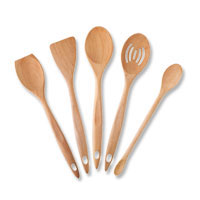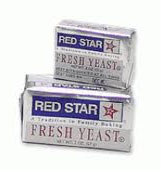Cook'n 101: Basic Kitchen Information We All Need to Know!
By Alice Osborne
Good cooking isn't an accident. It comes with desire and practice. But it doesn't hurt to learn from the mistakes of others along the way. We can save a lot of time, money, and misery by taking the advice of the pros now and then. When it comes to tools, utensils, and ingredients, there are some things we all need to know!
 For instance, I learned the hard way that I shouldn't dunk a hot pan in cold water or ice water. I warped the bottom of one of my favorite pans - it never did sit flatly on the stovetop afterwards. I tried to continue using it, but the resulting in hot spots and uneven heat distribution really messed up my cooking. I eventually had to toss the pan. Thank goodness it wasn't an expensive one.
For instance, I learned the hard way that I shouldn't dunk a hot pan in cold water or ice water. I warped the bottom of one of my favorite pans - it never did sit flatly on the stovetop afterwards. I tried to continue using it, but the resulting in hot spots and uneven heat distribution really messed up my cooking. I eventually had to toss the pan. Thank goodness it wasn't an expensive one.
And speaking of pans, do you know the differences between a skillet and a saute pan? You should, because depending on what you're trying to cook, the process can be easy or hard.
A skillet's sloping side allows you to turn and remove food such as scrambled eggs more easily. In contrast, the comparatively high, vertical wall of a saute pan interferes with these cooking tasks. The rationale behind its construction is different: The design is meant to reduce the amount of oil that splatters beyond the saute pan's rim when, for instance, the cook pan-fries chicken.
 The sides of a saute pan, incidentally, should not measure more than 2 1/2 inches. Higher walls cause excess steam to build up in the pan as gaseous water molecules are released by the frying foods. Moreover, some of the imprisoned steam molecules then condense and fall into the oil, needlessly causing extra splatter and lowering the oil's temperature at the same time.
The sides of a saute pan, incidentally, should not measure more than 2 1/2 inches. Higher walls cause excess steam to build up in the pan as gaseous water molecules are released by the frying foods. Moreover, some of the imprisoned steam molecules then condense and fall into the oil, needlessly causing extra splatter and lowering the oil's temperature at the same time.
 And how about this! Did you know wooden spoons are not created equal? Some are pretty pricy - these are hardwood spoons. The question we can ask is if they're worth their higher price?
And how about this! Did you know wooden spoons are not created equal? Some are pretty pricy - these are hardwood spoons. The question we can ask is if they're worth their higher price?
Here's the deal: Hardwood spoons cost more than softwood spoons because they are made of more expensive material and are more difficult to carve. They absorb less bacteria and cooking flavors because hardwood is less porous. They are less likely to scorch, stain, crack, or warp. They dry faster, are more attractive, and last more than twice as long as softwood spoons. Good to know. I'm going to scout out hardwood spoons now.


Then there was something I learned from my own experimentation, and this had happy results: Dry and compressed yeasts are interchangeable. One packet (about one scant tablespoon) of active dry yeast has the leavening power of one standard cake of compressed yeast. Since compressed yeast contains 70% moisture (compared to only 8% for dry yeast), it must be stored in the refrigerator - and even then it loses its leavening effectiveness in about two weeks.
Dry yeast doesn't need refrigeration, but it must be stored in an airtight container or it'll absorb water from the atmosphere, raising its moisture content. That reactivates the yeast's metabolic enzymes, awakening the dormant yeast cells.
Now we know, so we can save ourselves some time, money and misery! If YOU have a cooking or baking tip you could share, please do. We'd love to hear from our Cook'n pros out there, so pass on your hard-earned wisdom!

